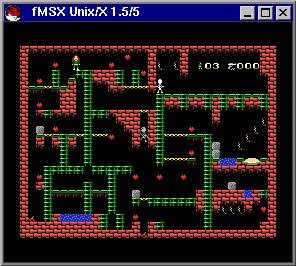
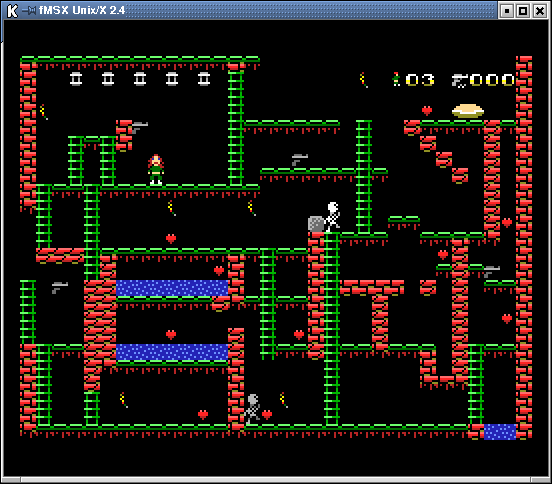
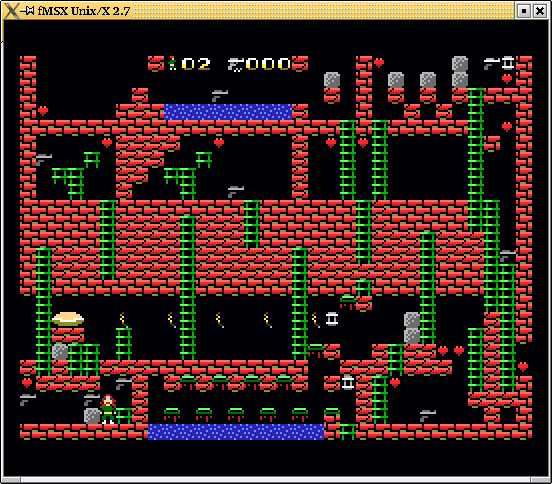

In 1988-1990, during high school, I was very much into MSX computers and I coded a lot but for only my own satisfaction. Now, in the Internet era (I think I made the first version of the current page around 1996), I have decided to make some of my programs to be in the public domain. That is, you can freely copy them under the condition that you let me know how did you like them! It was back in 1990 when I did anything with MSX; I cannot guarantee that they run on every MSX computer or emulator that is out there now (though I hope they will!).
For those who do not know what an MSX is, I suggest looking first at the wikipedia page and then at http://www.msx.org. An MSX II computer had a 3.58 MHz 8-bit Z80 processor, 128 KB (or less) RAM, and 128 KB VRAM. It had several different graphics resolutions, from which 256x212, 16 colors, was the most popular for gaming. While it was less powerful than 16-bit homecomputers like Amiga available at the same time, it benefitted by dedicated support from Japanese game developers like Konami. It had games like Metal Gear, Metal Gear II, and Vampire Killer (precursor of Castlevania). (The MSX I computer had much less powerful graphics, but still good games.) Moreover, Amigas were too expensive for our country at that time.
I lived in Estonia that was at that time still occupied by the Soviet Union. At the high school, we had a Yamaha KYBT MSX-2 "basic" network (one YIS805 and 9 YIS503III's) (as far as I remember), with peculiarities like Russian keyboard and Russian fonts in ROM. At this time, MSX-s were almost the only computers with full programming environment available in Estonia, so it is not a wonder they became that popular. In particular, the concrete model of MSX-2 was quite well-known, and Estonia had at least four computer classes of them. (Recall this was dark ages, and in Soviet Union! So four classes was a lot.)

|

|

|

|
The game was written from late 1989 to summer 1990 when I was in the last year of high school. I was the coder, idea generator, etc. My classmate Indrek Pinsel, now a professional programmer and a free-time DJ, wrote the music and parts of the music coding. He and two-years younger Alar Koot, who is now a professional designer, also helped me with the graphics. In particular, Alar helped me to design the final screen and some of the tiles. Many other pupils (like Helvis Ints) provided invaluable help continuously play-testing the game. Several levels would have been much simpler or more boring without their ingenuity. Note: the game is said to be copyrighted by the "Santa Claus Software." Of course, there was no such company. It was just I and my friends.
About the name of the game. I just happened to design a redheaded protagonist. So it was proper that I, then at high school, assumed that he is Irish. Moreover, O'Connor sounds very Irish. (Though I later became to regret the choice, since the inclusion of the apostrophe in file names can be problematic.) The first name of O'Connor might have been Patrick; it is not mentioned anywhere in the files, and I really do not remember. Maybe he did not have any first names. "Among the falling walls" was a logical part of the name, since the walls really fall in this game. An earlier name of the game was called "O'Connor in the cellars of Boston" because the levels look like dungeons, and "cellars of Boston" was an internal joke (a meme) about something that we had at this time. (Why Boston? Which joke? I do not remember, again, ...)
"O'Connor" is somewhat similar to the well-known MSX games "Rise Out" and "Lode Runner" --- it is a platformer-puzzle, with one screen = one level. At every level, you must collect all "collectibles" (hearts, by some unspecified reason) and then reach an "exit" (a key). You can shoot walls like in "Rise Out," there are also enemies (two skeletons) whom you cannot shoot, and ladders to climb. However, "O'Connor" has much more possibilities than either "Rise Out" or "Lode Runner." The most innovative factor of this game was its dynamicism: many walls, floors, ladders, almost everything can change their location (in a deterministic way) due to your actions. You can push stones, shoot certain construction elements so that they start to move (and then construct floors or routes from them, or block enemies), etc. So, the very room itself changes during the game several times. Hence, it is a puzzle game. All actions are deterministic, and you have to figure out what to do when and at what order. Some of the later levels are quite challenging (although earlier levels are often too easy...), and it may take a while to find out the winning solution. My own favorite was level 18.
Keys: Space (shooting), arrows, "select" (selecting a level), F1 (suicide).
The easiest way to try: you can play it online: MSXGamesWorld link.
Alternatively, here are the files:
Copy both of the files to the floppy disk (similarly when you use an emulator) and thenBLOAD "OCONNOR.GM1",R BLOAD "OCONNOR.GM2",R
To run it you'll need the MSX computer to have at least the 9938 videoprocessor introduced with MSX-2 (O'Connor runs in SCREEN 4, and makes the full use of user-defined palette and also of more colorful sprites compared to SCREEN 2 of 9918, present in MSX 1), but not the MSX-2 BIOS, so "O'Connor" runs on old SVI 738 by Spectravideo (or so called MSX 1.5). Running on MSX 1.5 was actually one of the goals since at this time, the SVI 738 computer was popular in Finland, and I was hoping to sell the game there. (NB! "O'Connor" does not run on MSX I, though.)
Moreover, "O'Connor" should run on most of MSX2 emulators, too. I've tried it myself on fMSX-unix v 2.7 with the flag -msx2 (on Linux) and on blueMSX 2.8.2 (on Windows XP and later), on OpenMSX 17 (Mac), and it worked perfectly on all of them.
The game is written in pure Z80 assembly. Since I cared about backward compatibility, I did not use BIOS calls for MSX 2 specific graphics, so it should run on "MSX 1.5". All 8x8 tiles (walls, staircases, ...) in "O'Connor" (including for O'Connor himself and the skeletons) were designed by using the Editor of Items (see below).
Please let me know if you have tried O'Connor: did you like it?
Some user comments:
--- Answer: I'm not an expert in LodeRunner AI; but you can try with : - Rise Out (but you already know this game, isn't it?) - Lode Runner + (only for MSX2+/TR) park15.wakwak.com/~n_i/msx/p4.html - O'Connor (MSX2/2+/TR) research.cyber.ee/~lipmaa/msx/ The late being specially impressive... Greets --- And thank-you reply: Hey that O'connor game is very cool I never saw that one before but it's quiet fun to play!
A character editor called Editor of Items (version 1.5) for Screen 2 and Screen 4 that also works with 9918, but it also knows how to use some extra features of 9938, so you can define palettes, etc. You can edit 8x8 and 16x16 symbols that were suitable also to use as sprites, their colors row by row, a test screen editor. A lot of functionalities everywhere but a bit uncomfortable to use. It was used by me to design all the symbols and sprites in O'Connor.
Copy both of the files to the disk and then
RUN "ANIM.BAS"
Set Up! was made using my "trademarked" method to code the
stupid things (e.g., disk operations) in MSX-BASIC. I hope you'll like
the editor. It has everything me and
my friends programmers have ever needed.
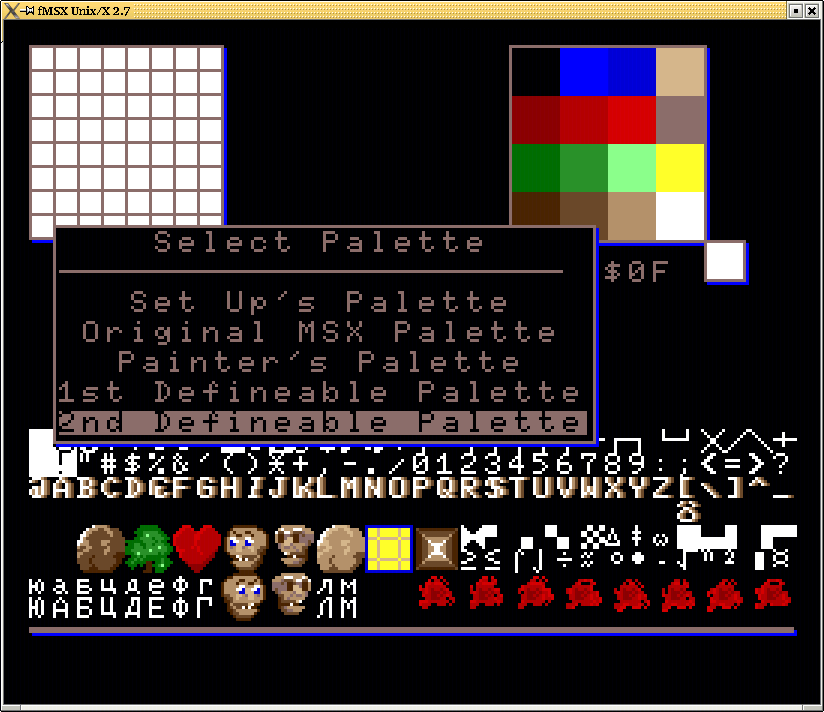
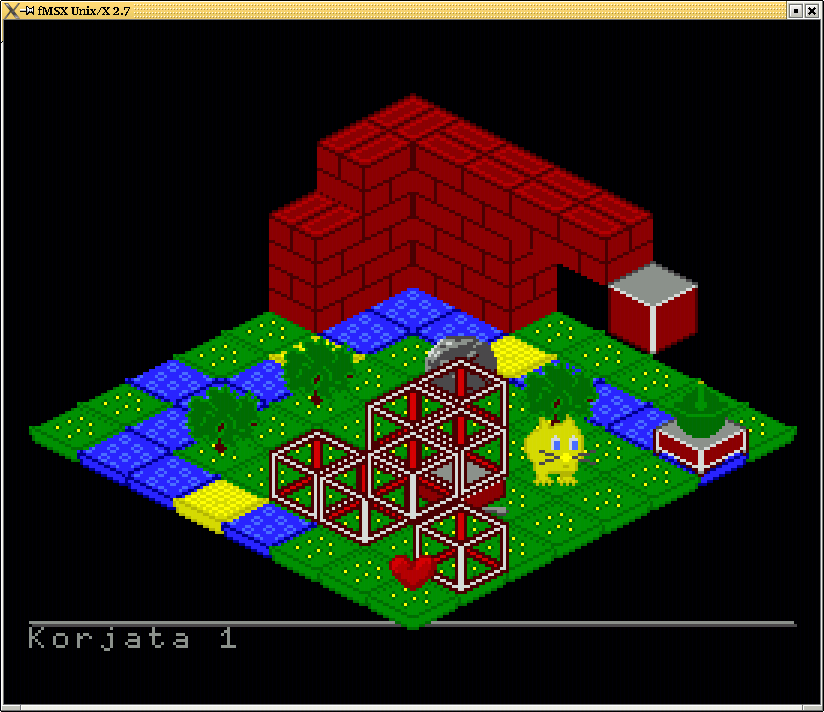 bat5 was my attempt to implement an isometric game like
"Batman" and "Head over Heels" in Screen 5, but the VDP was
too slow for it. Still, I did design the symbols and made some of the
central machinery to work. (The guy moves and jumps, there are horizontally
moving lifts that can carry you, you can collect items, and change the
positions of boxes.) Note: I did the different isometric symbols by
using Edit 5.
bat5 was my attempt to implement an isometric game like
"Batman" and "Head over Heels" in Screen 5, but the VDP was
too slow for it. Still, I did design the symbols and made some of the
central machinery to work. (The guy moves and jumps, there are horizontally
moving lifts that can carry you, you can collect items, and change the
positions of boxes.) Note: I did the different isometric symbols by
using Edit 5.
I probably will never give a link to this one.
I went to a high school in Pärnu, to a class that had deepened education in mathematics and physics, pluss also we learned programming. (It might have been the only high school in the city that had computers at that time!) We were very active in the computer class: we first had the Soviet Agat computer and then got a MSX II class. A lot of our pupils spent their days in the computer class. Some other MSX guys from our school were:
From those people, I only have programs written by myself. Ville and Indrek programmed more actively on the Agat computer.
Other guys from Estonia whom I can remember: Janno Ossaar, Markus Klesman, ... There is also an MSX mailing list at lists.ut.ee.
I am sure there is a lot of software out there, some of it might be lost. Next, I only list things that I have a copy of.
Kain Väljaots has uploaded a copy of his old MSX notebook.
In 1990, I participated in the Soviet Union Informatics Olympiad in Kharkov. I made friends with the local MSX guy, Ted Chary (Alex Garmash). From him, I got a lot of software, including some done by themselves. For example, they had made Nike DOS, an MSX-DOS based DOS (with many additional features).
Tuuli Lepik wrote an MSc thesis END IF ehk varane arvutikunst ja uute meediate algus on the people in Estonia in 80's who worked on early computers. It has a section (Section 8.6) on my production. In Estonian.
Passion MSX has a posting about Estonian MSX games.
Mail to me: <helger.lipmaa>![]() gmail.com (Helger Lipmaa)
gmail.com (Helger Lipmaa)
for